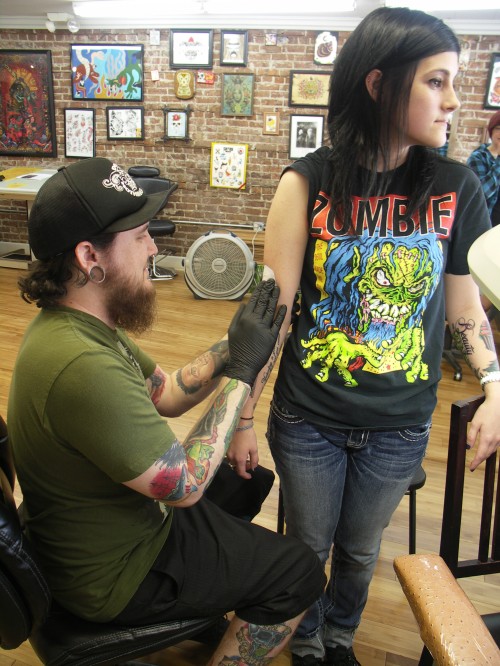
BP donates $50,000 to NSU scholarship program
October 9, 2012Bessie Turner
October 11, 2012Eddie Snyder said he wanted to be an artist, but did not initially think in terms of tattoos. Now he is making his mark as a respectable business owner and body artist. He insists high standards separate his work from stereotypes of other parlors and an underground industry.
With eight years tattoo experience and as former owner of Marvel Art (2007-11) on Houma’s west wide, Snyder said he wanted a central location for Copperhead Tattoo. “I like the idea of rejuvenating the downtown area and building it back up. I was looking for a place for about three years before this one opened up,” he said of his Main Street digs.
The bearded 27-year-old Snyder, along with his trained crew, all sport tattoos, as expected, yet display a professional and moderately conservative attitude toward conducting business in their open and bright location.
A Houma native, Snyder went to art school in Baton Rouge. “A guy opened a tattoo shop next to my apartment,” he said. “I started hanging out there getting tattoos and became friends with him. Being that I was an art student, he talked me into apprenticing. I wasn’t really looking to tattoo … but I ended up dropping out of school and tattooing full-time.”
Snyder said that while tattoo art has been around virtually as long as people could first mark on themselves, the business has increased by numbers in large part because of reality TV programs. “Everybody wants a tattoo because of these TV shows, or they think they want to be a tattoo artist. When I first started tattooing, money was really good, but with so many [people practicing], it changes the economy.”
This business owner explained in many states tattooing has actually been illegal and often operated as an underground industry. “In Oklahoma, tattooing has only been legal since 2008. North Carolina is a state where it just became legal. The tattoo scene was huge in New York, even when it was underground, but it only became legal in the last 10 years.”
Working to legitimize the artistic trade, Snyder said unfortunately many people begin tattooing out of their homes. He said his business is set apart from others in that many of his competitors have not undergone formal training and apprenticeships under master artists – a procedure he feels should be required. “There is licensing, but it is too lax in Louisiana,” he said, “At the same time, you don’t want too many laws.”
Snyder noted that “too many” tattoo artists are not licensed but “want to make a lot of money coloring on people.” He said “not enough” get sued for poor work or business habits.
Copperhead Tattoos’ styles focus on traditional American and Japanese designs. Snyder said those images age better.
According to Snyder, many patrons, as well as people applying tattoos, do not take into consideration how skin ages and changes over time. For that reason, his crew maps and applies tattoos made to stand the test of years.
“Simple and bold images are best,” he said. “If you try to get too artsy and fancy with it, over time it will look like a mess.”
Snyder said initial patrons also often do not realize small images they like from a magazine photo will have to be larger when made into a tattoo.
He said he does not exactly consult people on what they select, but does have standards and tries to get to know clients, then appropriately interpret their requests.
“We [try to discourage] tattoos on hands or on the neck because that can make it difficult for people in the workplace and is not good for their future,” Snyder said. “I’m not going to do something crazy like tattoo [male genitalia] on your forehead.”
Tattoo images come and go, but Snyder said most people want something personal to them. “Names are always popular or a famous singer might have a little infinity symbol, so people want that for awhile,” he said. “The biggest thing that has been popular since I’ve been tattooing have been fleur de lises, especially after [Hurricane] Katrina.”
Some tattoos come from established patterns, while others are custom designed by artists before it is even traced by stencil on a customer’s skin. The patron has an opportunity to check the piece in a mirror before giving a nod for the artist to continue working with ink injecting needles.
Snyder said ink companies do watch the safety of their products, but it remains an individual businesses responsibility regarding the level of sanitation and public safety – including use of either reusable or disposable needles.
“Actually, there is little regulation until there are complaints,” Copperhead Tattoo artist Rob Leger said. “That’s where having a good apprenticeship and founded education from a true tattoo master comes along. Then you will know what products are reputable.”
The cost of a tattoo can start at a minimum $50 for a small image, or expand as larger work is compensated at a rate of $100 an hour.
Snyder and Leger said reputable tattoo artists, while in competition, do have a community among themselves, just as is true with many mainstream professions. They exchange information to help one another. “But if the guy down the street doesn’t pay his dues and go through things the correct way, I don’t care if he is around,” Leger said.
Preconceived images from the general public, based on bad information, are what the artists at Copperhead Tattoo identify as their greatest challenge. “People have a lot of misconceptions about what makes a good tattoo,” Leger said.
Snyder said his rewards come with creating original work for a client and having that person like it. By accomplishing that goal, the artists at Copperhead know they have genuinely made a lasting impression.
Tattoo artist Nick Hutchinson prepares customer Gabby Fournier to receive her 13th tattoo. The staff at Copperhead Tattoo in downtown Houma want to be known for offering higher class quality and designs. They strive to separate themselves from the stereotype that has marked their trade.









